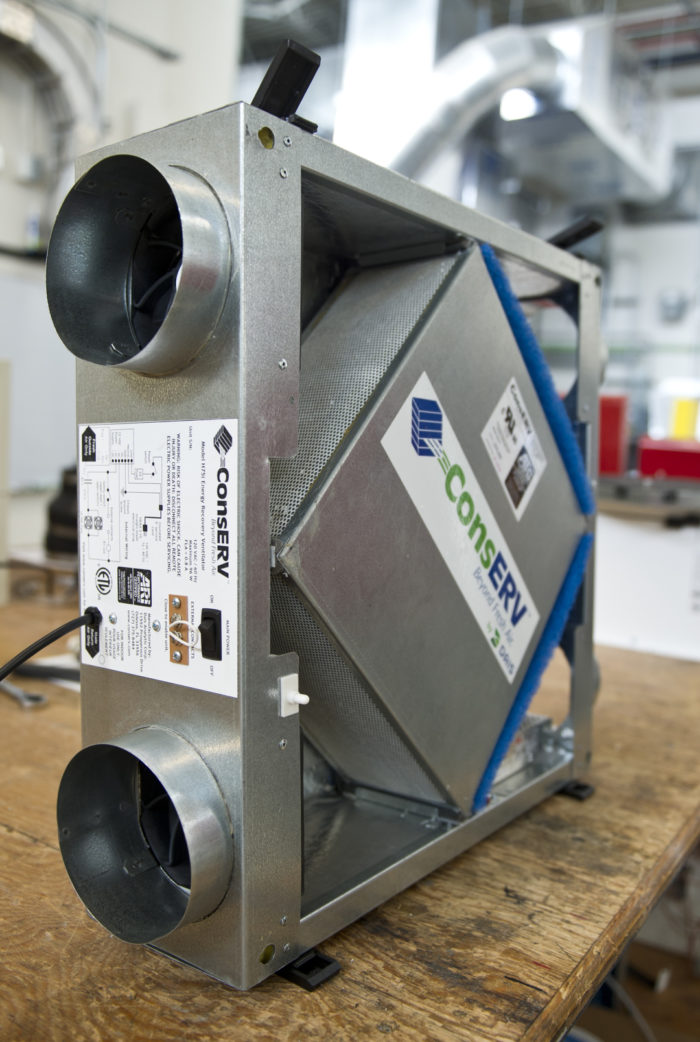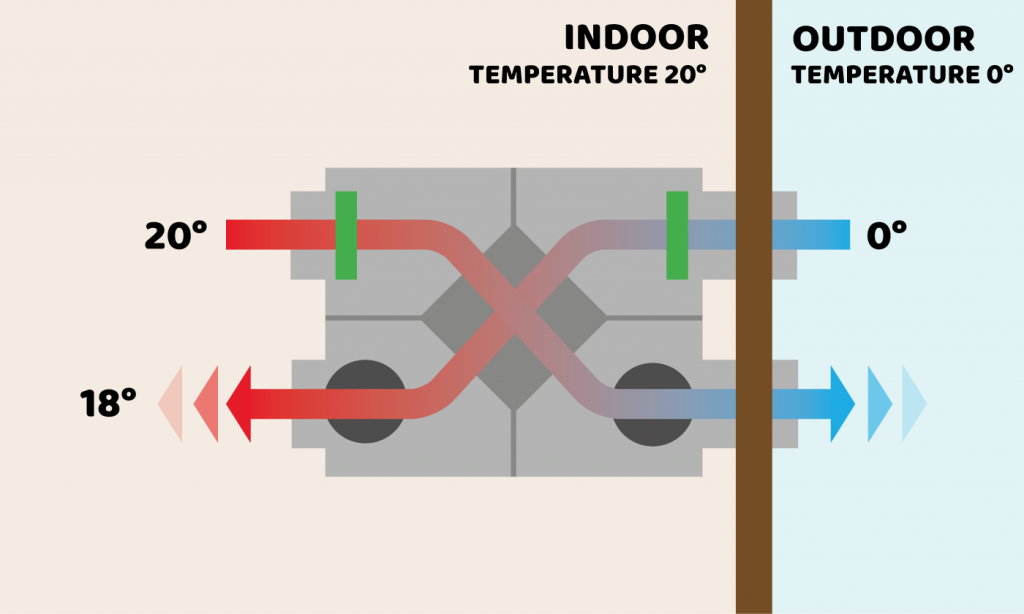Unveiling the Key Benefits and Uses of Heat Recovery Ventilation in Sustainable Style
Heat Recovery Ventilation (HRV) systems play an important role in lasting layout. They help with a continuous exchange of stagnant indoor air with fresh exterior air, greatly enhancing interior air top quality. HRVs add to energy efficiency by recovering warm from exhausted air, which can decrease energy costs. Understanding the multifaceted benefits and applications of HRVs discloses their value in modern-day design. What other advantages do these systems provide in the pursuit of sustainability?
Recognizing Heat Recovery Ventilation Systems
Heat recovery ventilation (HRV) systems are made to improve indoor air high quality while reducing energy loss. These systems make use of a mechanical ventilation method to exchange stale interior air with fresh exterior air, making certain a constant supply of clean air. By capturing heat from the exhaust air, HRVs precondition inbound air, decreasing the need on home heating and cooling systems. This process not just improves thermal comfort however additionally contributes to energy efficiency in domestic and business structures. Additionally, HRV systems aid manage moisture degrees and minimize indoor contaminants, promoting a healthier living environment. Their critical implementation is vital for achieving lasting design objectives, as they use a balance in between power preservation and occupant well-being.
Exactly How HRV Equipment Work
While many may know with ventilation systems, comprehending just how warmth recuperation air flow (HRV) systems operate is vital for valuing their advantages. HRV systems operate by trading stagnant interior air with fresh outdoor air while moving heat in between the two streams. This process happens in a warmth exchanger, where warm from the outbound air warms up the incoming air during cooler months, lessening energy loss. Alternatively, in warmer months, the system can cool inbound air making use of the cooler outgoing air. HRVs are outfitted with fans to assist in air movement and filters to get rid of particulates, ensuring a continuous, balanced ventilation procedure. This cutting-edge design not just enhances energy effectiveness yet also adds to preserving a comfortable indoor setting.
Enhancing Indoor Air Quality
Interior air top quality can considerably affect wellness and well-being, making reliable air flow important in contemporary homes. Heat Recovery Ventilation (HRV) systems play an important duty in preserving interior air high quality by constantly trading stagnant indoor air with fresh outdoor air. This process not only minimizes air-borne contaminants yet additionally reduces humidity levels, which can cause mold and mildew development and breathing issues. HRV systems filter incoming air, eliminating allergens and particulates, consequently supplying a much healthier living atmosphere. In addition, these systems help get rid of smells and unstable organic substances (VOCs) commonly found in house products. By ensuring a consistent flow of clean air, HRV systems add to a total better interior environment, promoting comfort and wellness for owners.
Energy Effectiveness and Expense Savings
Power performance sticks out as a substantial benefit of Heat Recovery Ventilation (HRV) systems. By recording and recycling the heat from worn down indoor air, HRVs decrease the energy required for heating inbound fresh air, bring about decreased power intake. This effectiveness equates into reduced energy bills, offering significant expense savings for home owners and businesses alike. In addition, HRV systems frequently qualify for power efficiency rewards and refunds, additionally enhancing their monetary charm. Gradually, the preliminary financial investment in HRV innovation can result in a positive roi through decreased power costs. As a result, the integration of HRV systems not just advertises lasting layout yet also offers a useful solution for attaining long-lasting energy savings and monetary advantages.
Ecological Advantages of HRV

A wide range of environmental benefits arises from the implementation of Heat Recovery Ventilation (HRV) systems. By successfully moving warmth from exhaust air to incoming fresh air, HRVs significantly lower the power required for home heating and cooling areas. This energy efficiency converts to reduce greenhouse gas emissions, adding to a reduction in the overall carbon impact of structures. Furthermore, HRV systems boost indoor air quality by continually flowing fresh air, thus minimizing the concentration of indoor pollutants and irritants. The reduction in power consumption help in conserving all-natural sources, making HRVs an important i loved this part of sustainable layout. In general, the ecological advantages of HRVs play an essential function in advertising a healthier world and promoting environmentally friendly structure practices.
Versatile Applications in Modern Style
Heat recovery ventilation (HRV) systems are increasingly being incorporated right into both household and business architectural jobs. In household setups, HRVs enhance interior air quality while maximizing power effectiveness. At the same time, in commercial rooms, these systems optimize air flow approaches, showing their flexibility in contemporary building applications.
Residential Projects Assimilation
While contemporary design increasingly stresses sustainability, the assimilation of warmth recovery ventilation systems in residential projects has actually become a functional remedy for boosting interior air quality and power performance. These systems effectively move warm from exhaust air to incoming fresh air, reducing power loss and reducing heating or cooling down needs. In brand-new builds and retrofits alike, warm recuperation air flow can be flawlessly included, offering house owners with a much healthier living setting while lowering utility expenses. Furthermore, with raising recognition of ecological influences, more designers and building contractors are identifying the lasting advantages of these systems. As an outcome, heat recuperation air flow has become an essential component of lasting household style, showcasing versatility and commitment to environmentally friendly techniques.
Business Areas Optimization
As modern business areas evolve to fulfill the demands of sustainability and effectiveness, the implementation of heat recuperation ventilation systems becomes a key approach for enhancing interior atmospheres. These systems help with the exchange of stagnant indoor air with fresh outdoor air while recovering heat, significantly decreasing power consumption. This not just enhances comfort for owners however additionally assists in decreasing operational prices. Versatile applications can be observed in workplaces, retail spaces, and universities, where air top quality and temperature control are extremely important. Furthermore, integrating heat healing air flow lines up with environment-friendly building accreditations, better promoting environmental duty. Ultimately, adopting such systems in business style not only contributes to sustainability objectives however likewise cultivates much healthier, much more effective spaces for individuals.
Integrating HRV Into Sustainable Design Practices
Integrating warmth recuperation ventilation (HRV) systems right into sustainable style practices supplies significant benefits in energy effectiveness and interior air quality. By utilizing HRV, developers can develop cost-efficient solutions that not just lower power usage however likewise improve the overall convenience of interior atmospheres. This positioning with sustainability goals positions HRV as a necessary component in contemporary architectural techniques.
Power Performance Improvement
By integrating warm recovery air flow (HRV) systems right into sustainable layout techniques, engineers and contractors can considerably boost energy performance in modern constructions. HRV systems work by recording warm from outward bound stale air and transferring it to incoming fresh air, decreasing the power required for home heating or cooling interior areas. This procedure her latest blog not only reduces dependence on conventional heating and cooling systems but likewise lowers total power consumption. On top of that, HRV systems can help preserve a consistent interior temperature, reducing peak power demands. By incorporating these systems, structures can accomplish substantial reductions in energy costs and carbon footprints, lining up with sustainability objectives. Eventually, HRV modern technology represents a sensible service for link improving power effectiveness in the constructed environment, advertising more accountable source usage.
Indoor Air Quality Renovation
How can warm healing air flow (HRV) systems add to remarkable indoor air top quality in modern buildings? HRV systems effectively exchange stale interior air with fresh outdoor air while recuperating heat, decreasing temperature changes. This procedure decreases the focus of interior toxins, such as unstable natural compounds (VOCs), allergens, and wetness, which can degrade air top quality and influence occupant health and wellness. By maintaining excellent humidity levels and making sure a constant supply of tidy air, HRVs aid develop a much healthier indoor atmosphere. Additionally, these systems can be incorporated right into lasting style techniques, advertising power performance along with boosted air top quality. HRV Heat Recovery Ventilation. Consequently, HRV technology plays a vital role beforehand total owner convenience and health in modern architectural styles
Affordable Design Solutions

Frequently Asked Questions
What Upkeep Is Needed for Heat Recovery Ventilation Solutions?

Maintenance for warmth recovery ventilation systems usually involves routine filter substitutes, cleaning of warmth exchangers, evaluation of followers and ducts, and ensuring proper drain. These jobs aid keep performance and extend the system's lifespan over time.
Can HRV Solutions Be Installed in Existing Buildings?
Heat recovery ventilation systems can without a doubt be mounted in existing buildings. HRV Heat Recovery Ventilation. Retrofitting calls for cautious preparation and analysis of the building's design, making certain compatibility with current systems while making best use of power efficiency and interior air top quality
Just How Do HRV Systems Effect Sound Degrees Inside?
HRV systems can influence indoor sound degrees by presenting noise from external sources via ventilation. High-quality installments usually include sound-dampening attributes, reducing sound effect while supplying effective air exchange and preserving convenience inside your home.
Exist Any Type Of Drawbacks to Utilizing HRV Solutions?
The downsides of using HRV systems consist of possible high first expenses, maintenance challenges, and the possibility of decreased indoor air quality if filters are not on a regular basis transformed, which might cause problems with humidity levels.
Exactly how Do I Choose the Right HRV System for My Needs?
Choosing the appropriate warm recovery ventilation system entails reviewing details requirements, such as constructing size, climate, and power effectiveness objectives. In addition, assessing system features, installment needs, and maintenance considerations is necessary for peak efficiency and contentment.